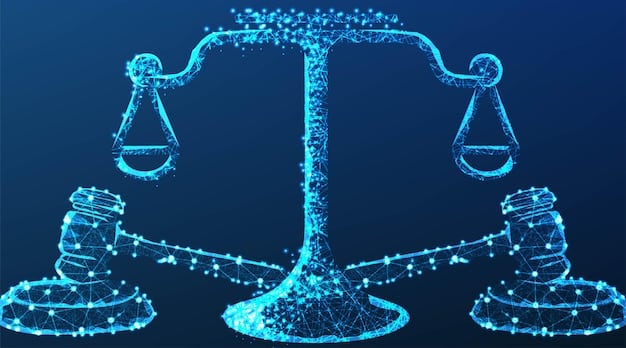Examining Social Media’s Algorithm Role in Shaping Social Justice Views in 2025

Examining the Role of Social Media Algorithms in Shaping Public Opinion on Social Justice Issues: A 2025 Analysis reveals how algorithms on platforms like Facebook, Twitter, and Instagram increasingly influence perspectives on critical social justice topics, potentially reinforcing biases or promoting specific narratives.
The digital town square, once envisioned as a space for open dialogue, is now heavily curated by algorithms. Examining the Role of Social Media Algorithms in Shaping Public Opinion on Social Justice Issues: A 2025 Analysis becomes crucial when we consider the subtle yet powerful ways these algorithms influence what we see, read, and ultimately, believe. How are these algorithms changing the landscape of social justice debates? Let’s delve into the impact of algorithmic curation on public discourse.
This exploration aims to shed light on the current state of affairs and to highlight potential future challenges. As we move toward 2025, understanding Examining the Role of Social Media Algorithms in Shaping Public Opinion on Social Justice Issues: A 2025 Analysis becomes vital for remaining informed and promoting balanced discussions.
The Algorithmic Echo Chamber and Social Justice
Social media algorithms, designed to personalize user experience, often create echo chambers. These online spaces reinforce existing beliefs, potentially skewing perspectives on complex issues like social justice. How does this algorithmic filtering impact the broader public understanding of social justice?
Personalized Feeds and Filter Bubbles
Algorithms analyze user data to predict and deliver content that aligns with their preferences. This personalization, while enhancing user engagement, can also limit exposure to diverse viewpoints, trapping individuals in “filter bubbles.”
- Reinforcement of existing biases.
- Limited exposure to opposing perspectives.
- Increased polarization of opinions.
The consequences of these filter bubbles are significant, especially in the context of social justice, where nuanced understanding and empathy are vital.
The Spread of Misinformation
Social media platforms have struggled to combat the spread of misinformation. Algorithms, optimized for engagement, can inadvertently amplify false or misleading content, further distorting public opinion on social justice issues.
The combination of algorithmic curation and the viral nature of social media creates a breeding ground for misinformation and biased narratives. This can have a devastating impact on constructive social justice dialogue.

Examining the Role of Social Media Algorithms in Shaping Public Opinion on Social Justice Issues: A 2025 Analysis
To fully grasp the implications, we must analyze how different algorithms operate. Examining the Role of Social Media Algorithms in Shaping Public Opinion on Social Justice Issues: A 2025 Analysis involves understanding the mechanics of these systems and their capacity to influence.
Facebook’s News Feed Algorithm
Facebook’s algorithm prioritizes content from friends, family, and engaged communities. This focus on familiarity can inadvertently marginalize diverse voices and perspectives on social justice.
- Prioritization of “relevant” content based on user engagement.
- Potential for censorship of dissenting views.
- Amplification of sensational or emotionally charged content.
The ultimate impact is a personalized feed that confirms existing biases, shaping a distorted view of social justice realities.
Twitter’s Trend Algorithm
Twitter’s trending topics algorithm highlights popular conversations, often driven by hashtags. While this can amplify important social justice campaigns, it also opens the door to manipulation and the spread of misinformation.
The real-time nature of Twitter, combined with algorithmic amplification, creates a volatile environment for sensitive discussions around social justice. It is essential to understand the mechanics behind the trends to critically assess the information.
The Impact on Awareness Campaigns
Social media has become a popular tool for raising awareness about social justice issues. Algorithms can either enhance or hinder the reach and impact of these campaigns. How can social justice movements leverage algorithms for positive change?
Amplifying Marginalized Voices
Algorithms can be used to amplify the voices of marginalized communities and bring attention to overlooked social justice issues. By strategically using hashtags and engaging content, activists can leverage algorithms to reach a wider audience.
However, the dependence on algorithms can also create risks, as platforms retain control over content visibility and may be subject to censorship or bias.
Challenges and Obstacles
Social justice campaigns often encounter algorithmic bias and censorship. Platforms may algorithmically suppress content deemed controversial or politically sensitive. This can significantly limit the visibility of important social justice initiatives.
Navigating these challenges requires a deep understanding of algorithmic dynamics and the development of innovative strategies to overcome bias and censorship.
Combating Algorithmic Bias
Algorithmic bias, often embedded in the design and training data, can disproportionately affect certain communities. Examining the Role of Social Media Algorithms in Shaping Public Opinion on Social Justice Issues: A 2025 Analysis involves identifying and addressing these biases.
Identifying Bias in Algorithms
Algorithms are trained using data, and if the data reflects societal biases, the algorithm will perpetuate those biases. Identifying these biases requires careful analysis and a commitment to fairness.
- Auditing algorithms for discriminatory outcomes.
- Promoting transparency in algorithmic design.
- Diversifying the data used to train algorithms.
By uncovering and mitigating bias, we can create more equitable social media environments.
Strategies for Mitigation
Mitigating algorithmic bias requires a multi-faceted approach. From diversifying data sets to designing algorithms with fairness in mind, there are several strategies that can be used to combat bias.
Additionally, holding social media platforms accountable for the impact of their algorithms is crucial for promoting responsible and equitable outcomes.

The Future of Social Justice and Algorithms
As we look towards 2025, the interplay between social justice and algorithms will likely intensify. Understanding the potential future scenarios is critical for shaping a more equitable digital landscape.
Technological Advancements
Advancements in artificial intelligence and machine learning will continue to shape social media algorithms. These advancements may lead to more sophisticated personalization but also increased potential for bias and manipulation.
Keeping pace with these technological advancements requires continuous monitoring and a proactive approach to addressing emerging challenges.
Policy and Regulation
Governments and regulatory agencies may implement policies to address algorithmic bias and promote transparency. These policies could impact how social media platforms operate and their responsibility for content curation.
Effective regulation can help ensure that algorithms are used ethically and promote equitable outcomes for all.
Promoting Balanced Discourse Online
Promoting balanced discourse and critical thinking is crucial for navigating the complexities of social media and algorithms. How can we foster a more informed and empathetic online environment?
Encouraging Critical Thinking
Encouraging critical thinking skills is vital for assessing information and avoiding the pitfalls of misinformation. By questioning assumptions and seeking diverse perspectives, individuals can develop a more informed view on social justice issues.
- Promoting media literacy education.
- Encouraging fact-checking and source verification.
- Fostering open dialogue and respectful debate.
These efforts will help create a more resilient and informed online community.
Building Diverse Online Communities
Building diverse online communities is essential for overcoming echo chambers and promoting balanced discourse. By engaging with individuals from different backgrounds and perspectives, we can broaden our understanding of social justice issues.
Creating inclusive and welcoming online spaces is crucial for fostering empathy and driving positive social change.
| Key Point | Brief Description |
|---|---|
| 📱 Algorithmic Echo Chambers | Algorithms can create filter bubbles, reinforcing existing beliefs on social justice. |
| 📣 Awareness Campaigns | Social media campaigns can be amplified or hindered by algorithms. |
| ⚖️ Combating Bias | Identifying and mitigating bias in algorithms is crucial for equity. |
| 🌐 Balanced Discourse | Promoting critical thinking and diverse online communities is essential. |
Frequently Asked Questions
Social media algorithms curate the content users see, often reinforcing existing beliefs and limiting exposure to diverse perspectives, which can skew their understanding of social justice issues.
Echo chambers are online spaces where users are primarily exposed to information confirming their existing beliefs, leading to increased polarization and hindering constructive dialogue on social justice.
Strategies include auditing algorithms for discriminatory outcomes, promoting transparency in design, diversifying training data, and holding platforms accountable for their algorithms’ impact.
Movements can leverage algorithms by strategically using hashtags, creating engaging content, and focusing on community building, but must also be aware of potential censorship and bias.
Policy and regulation can ensure algorithms are used ethically and promote equitable outcomes, impacting platform operations and responsibility for content curation related Examining the Role of Social Media Algorithms in Shaping Public Opinion on Social Justice Issues: A 2025 Analysis.
Conclusion
Examining the Role of Social Media Algorithms in Shaping Public Opinion on Social Justice Issues: A 2025 Analysis highlights the complex interplay between technology and social justice. While algorithms can be powerful tools for awareness and empowerment, they also present risks of bias and manipulation.
By promoting critical thinking, fostering diverse online communities, and advocating for equitable policies, we can shape a more just and informed digital landscape. As we move towards 2025, a proactive approach to algorithmic transparency and accountability is essential.





